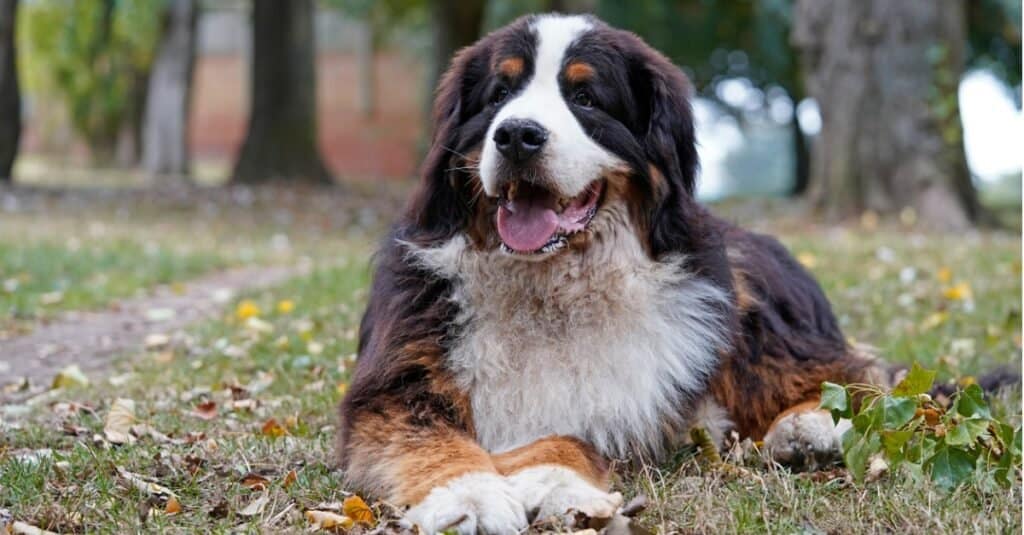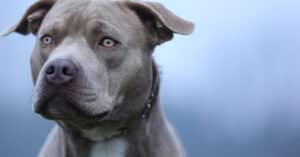Bernese mountain dogs originated from the canton of Bern in Switzerland where they served as hard-working farm dogs for millennia. Their long, thick coats helped keep them warm in all kinds of inclement weather. Today, these gentle giants are mostly companion dogs with sweet, calm dispositions and a high tolerance level for children. What many prospective Berner owners want to know is this: do Bernese mountain dogs shed? Read on to find out what you can expect from this breed’s gorgeous coat!
Do Bernese Mountain Dogs Shed?

The Bernese mountain dog sheds its coat all year round.
©iStock.com/Kriste Sorokaite
Bernese mountain dogs shed moderately throughout the year with additional periods of heavy seasonal shedding. If you’re looking for a hypoallergenic dog, this is not the breed for you. Berners are likely to trigger allergies in those prone to them.
Why aren’t Bernese mountain dogs hypoallergenic? Like most breeds, Berners produce a moderate amount of dander, the leading pet allergen. Dander is simply flakes of dead skin. In general, the more a dog sheds, the more dander it releases into the air. Because fur-bearing dogs shed more, they are likelier to trigger allergies than hair-bearing dogs.
How Much Do Bernese Mountain Dogs Shed?
Bernese mountain dogs shed moderately on an ongoing basis. Owners can expect frequent sweeping, vacuuming, or lint-rolling throughout the year. However, as any experienced dog owner knows, double-coated breeds like the Berner go through an additional period of massive shedding twice a year. Experts call this “blowing the coat.”
Berners blow their coats seasonally in spring and fall in response to temperature changes. In spring, they rid themselves of their heavy winter coat in preparation for warmer weather; in fall, they shed their lighter summer coat to make room for added protection against the cold. This process lasts for two to four weeks on average and results in copious clumps and tufts of fur around the house and yard. Berner owners may want to consider purchasing a powerful pet vacuum to keep up with the mess.
Do Bernese Mountain Dogs Have Hair or Fur?

Bernese mountain dogs are double coated.
©otsphoto/Shutterstock.com
Bernese mountain dogs have fur instead of hair. Both contain the protein keratin and are chemically identical, but there are nevertheless important differences. See the following sections for Berner coat characteristics.
Shedding
Fur-bearing dogs shed more than dogs with hair. The reason has to do with the respective growth cycles of hair and fur. Hair has a longer growth cycle between anagen (the growth stage) and exogen (the shedding stage), which means the follicles don’t replace themselves as quickly. This also gives the hair a chance to grow to greater lengths. Fur has a condensed growth cycle, which means it falls out faster and tends to be shorter in length.
Layers
Dog coats made of hair only have one layer. As fur-bearing dogs, Bernese mountain dogs are double-coated, which means they have two layers of fur. The underlayer (ground hair) is softer and finer than the outer layer (guard hair). Ground hair provides extra insulation for Berners while guard hair provides a protective barrier to keep out moisture and dirt. When the underlayer does get wet, the coat takes a long time to dry.
Texture
Unlike many fur-bearing dogs, the Bernese mountain dog has moderately long hair that can be either wavy or straight. Their coats lack the bristly, coarse texture of many double-coated breeds, giving them a luxuriant, touchable feel. Kinky, coarse, or overly curly hair is not desirable in a Berner according to official breed standards.
Grooming a Bernese Mountain Dog
If you’re going to own one of these regal dogs, be prepared for a lot of grooming. Owners should brush their Berners at least weekly and more often if possible. This is essential to keep the soft undercoat from matting and tangling with the longer outer coat. A good-quality slicker brush (a pin brush that helps detangle and remove loose hairs) is vital to keep a Berner’s coat in good condition. To get right down to the skin and undo stubborn knots, consider using a steel comb in addition to a slicker brush. A de-shedding tool will remove loose hair from the undercoat and reduce the amount of fur that ends up on your floors.
Avoid bathing your Berner too frequently as it strips the skin of its natural oils. This leads to dry, itchy skin and a dull, listless coat. You shouldn’t need to bathe your Bernese mountain dog more than once every four to eight weeks unless it gets dirty or smells. Working dogs may need more frequent baths than companion dogs.
Should you shave your Berner to reduce shedding? The answer is no. Unless there’s severe matting, a professional groomer will typically tell you not to cut or shave your Berner’s coat. This breed uses its double coat to regulate its body temperature in both hot and cold weather. It’s a myth that shaving down a dog makes them feel cooler in warm weather. Also, it tends to make the fur grow in even thicker, which only increases shedding over the long term.
How to Reduce Shedding
If you’re finding that the amount of fur around the house is getting to be a bit much, take a look at the following ways to cut down on your Berner’s shedding. Also, check out the review articles included below to find out which products will serve you and your dog best.
- Brushing: Brushing is the best way to care for your dog’s coat and also reduce the amount of fur around the house. A good brush will effectively remove loose hairs before they can get on the furniture.
- De-shedding brush: Some brushes are better at removing dead hair than others. See the following article for the best de-shedding dog brushes out there.
- De-shedding shampoo: Take bath time to the next level with a good shampoo designed especially for heavy shedders. Check out this article for our review of the best de-shedding shampoos for dog owners.
- Dog blow-dryer: After a bath to remove dead hair, a good blow-dryer can help blow away additional loose fur. If you find you’re struggling with your Berner’s shedding, consider investing in one of these high-quality grooming blowers.
- A healthy diet: There’s no substitute for a well-balanced diet. Take a look at these high-quality dog foods for shedders.
Conclusion
Bernese mountain dogs do shed quite a bit, so be prepared for regular clean-up if you decide to bring one of these dogs home. Though owners should not trim their Berner’s coat, try one of these grooming shears for tidying up feet and ears.
Up Next:
The photo featured at the top of this post is © Eve Photography/Shutterstock.com
Ready to discover the top 10 cutest dog breeds in the entire world?
How about the fastest dogs, the largest dogs and those that are -- quite frankly -- just the kindest dogs on the planet? Each day, AZ Animals sends out lists just like this to our thousands of email subscribers. And the best part? It's FREE. Join today by entering your email below.
Thank you for reading! Have some feedback for us? Contact the AZ Animals editorial team.






